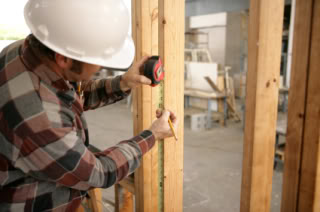What is Rough Framing?

If you walk by a construction site and see the building skeleton, it may seem the real construction work has yet to begin. However, the skeleton, or rough frame, is the building's most important structural component. Construction specialists worked on the rough framing to turn blueprints into the sturdy internal structure of the building.
Residential rough framing
For most homes, construction framers measure, cut and assemble lumber for the walls and subfloor, adding anchors and other vital structural supports. A rough framing carpenter also measures and attaches studs around the spaces for doors and windows, and sets joists for the ceiling, then trusses for the roof. Complicated geometrical calculation is required if the house includes arches or cathedral ceilings.
Rough framing skills
Rough framing carpenters may hone their skills in a wide range of rough framing or specialize in one style. The majority of rough framing, as described above, uses standard lumber studs at 16-inch spacing. Alternatives include insulating concrete forms and new types of lumber that allow wider spacing. These are becoming popular because they allow for more insulation and lower energy costs. However, construction framers need specialized skills and knowledge to maintain a building’s structural integrity while moving away from standard rough framing. Rough framing carpenters typically also specialize in commercial construction, tract home developments or custom home construction. There are both apprenticeships and classroom education opportunities for all types of rough framing carpentry careers.
Custom homes vs tract housing
Mark Currie, veteran rough framer and author of "Rough Framing Carpentry," said custom homes offer the widest variety of work and the steadiest pay. He thinks it is the best option for beginning rough carpenters, but may be frustrating because of constant changes and possibly inaccurate plans. Tract housing requires different construction framing skills. The rough framing work may be more monotonous, as crews tend to be more specialized in a tract home development. Pay is dependent on working as fast as you can on relatively repetitive tasks. The pay can be higher but less dependable than on a single custom home project.
Commercial projects
Commercial projects are typically reserved for big companies and unionized workers. Oversight is strict, rules are rigid and the work tends to be specialized and monotonous. However, pay and benefits can be very good with large companies, and job security will be higher for a unionized rough carpenter at a successful company.
Working as a rough framer
The work cannot be outsourced and few amateurs will take on a job as important as rough framing, so there will always be a need for rough framers. However, a weak real estate market can slow construction, limiting work opportunities. The work is also heavily dependent on weather conditions.
For a rough framing job, there is little room for error and potentially deadly consequences of shoddy work that is not structurally sound. Having said that, skilled rough framing carpenters learn how to work quickly and efficiently to maximize their profits.
Author Steve Graham is a former construction manager and newspaper editor. He has written more than 2,000 articles for Web sites, magazines and newspapers.
Updated January 14, 2018.
Looking for a Pro? Call us (866) 441-6648

Carpentry Average Costs
Carpenters Experiences

Concrete Patio Is The Finishing Touch For An Artist's Studio

My Awesome New Deck Built Off My Master Bedroom



